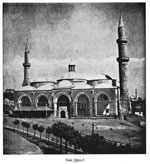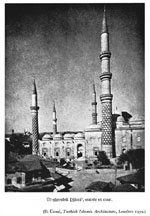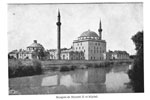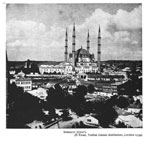Mosques:
The first Friday prayers were said in Edirne in a converted church inside the castle, known afterwards as the
, after its first müderris, al- b. , a teacher of the Conqueror, and also as . Ruined in an earthquake in the 18th century and later repaired, it survived until the end of the 19th century. Another church in the castle was converted into a mosque under the name of Kilise , but this was pulled down by II and replaced by one with six | [II:685a] domes which disappeared in the second half of the 18th century. The oldest surviving mosque is that of , built in 801/1399, on the foundations of a church ruined in the Fourth Crusade, so that the is built into a side wall. During their occupation of 1878 the Russians stripped the inside of the mosque of its tiles and of the two linked marble rings which had given the mosque the name of Küpeli (Ear-ring mosque). Another old mosque, the Eski (or Old Mosque par excellence) was started in 804/1402 by (hence the name of given it by I, a name which was later changed into Ulu , or Great Mosque, before the present one of Eski or was finally adopted) and completed in 816/1413 under I (Pl. X). The interior is square, 9 domes being supported by four columns. An inscription on the western gate, gives the name of the architect as al- of . A stone from a corner of the was placed at the time of building in the window to the right of the , and has been venerated ever since. In the 18th century the mosque suffered in a fire and an earthquake and was restored by I. Another mosque, the , was built by II first as a house of dervishes, a smaller - being built next to it when the main building was turned into a mosque. This mosque is distinguished by the excellent tiles which cover the and part of the walls. In the 10th/16th century this mosque, with its almshouse and other adjuncts, was in receipt of very large revenues. Another formerly rich mosque, the al- (which had at the beginning of the 11th/17th century a revenue of over half a million aspers), was originally a medrese, completed in 839/1435. The minaret of this mosque was destroyed in the siege of 1912. Several princes and princesses are buried in a nearby türbe.Eski .
- , entrée et cour., (B. Ünsal, Turkish Islamic Architecture, Londres 1959.)
Mosquée de
II et hôpital.., (B. Ünsal, Turkish Islamic Architecture, Londres 1959).
Another building going back to II is the
- (Three-Balconied Mosque) started in 841/1437-8 and finished in 851/1447-8 (Pl. X). says that it was built at the cost of 7,000 purses, being the proceeds of the booty captured at the conquest of Izmir. This mosque has also been known as the , Yeni (New Mosque) and -i (Great Mosque). The building is rectangular, a great dome being held up by six columns, there being four medium-sized and four other small domes at the sides of the main one. Four of the columns (at either side of the main gate and the ) are built into the walls. The (sacred enclosure, i.e., court-yard), paved with marble, is regarded as the first of a mosque built by the Ottomans. The cloisters on the four sides of the are made up of 21 domed vaults, supported by 18 columns. The three-balconied minaret is known as the first Ottoman minaret of this kind. There is also one minaret with two balconies and others with one balcony. II first allocated for the upkeep of this mosque the revenues of the silver mines at Karatova in Serbia. Later Rüstem transferred these mines to the Treasury, allowing the mosque to draw money instead from the of II. An important event in the history of the mosque was the public condemnation in it by al- of the followers of , who were believed to enjoy the sympathy of Sultan the Conqueror. II built on the banks of the a mosque, baths, a hospital, a medrese and | [II:685b] an almshouse (Pl. XI). A chronogram on the mosque gate yields the date 893/1488. The building was financed with the booty captured at - .The mosque is a simple structure, without arches or pillars, the dome being supported by the four walls. Baths ( - ), surmounted by nine domes and consisting of four rooms each, adjoin on either side and lead onto the two slender minarets. The marble minbar of the mosque is particularly elegant. The mosque contains also the first private gallery ( ) built in an Edirne mosque; this is supported by porphyry columns, brought probably from the ruins of some temple. The hospital ( al- ) built to the west of the mosque is a hexagonal building, six further rooms for the isolation and treatment of patients standing in the hospital gardens (where,
tells us, the patients were regularly made to listen to music). The medrese stands in front of the hospital, while the almshouse and a bakery lie to the east of the mosque. II had a quay made on the bank of the , in front of the of the mosque, and also widened the course of the river. The most beautiful monuments built in Edirne in the 10th/16th century are the work of the architect . One of these mosques (the , converted by from the of ) is no longer in existence. Three still stand: the , the mosque of , and finally the mosque of Sultan ( ), which is the glory of Edirne and the last royal mosque in the city (Pl. XI). Built between 972/1564-5 and 982/1574-5 according to the chronogram on the gate of the , it cost, tells us, 27,760 purses obtained from the booty captured in Cyprus. The great dome of the mosque, which rests on 8 columns, is 6 cubits ( ) higher than that of Saint Sophia in Istanbul. The 's gallery under the great dome is supported by 12 marble columns, two metres high; under it there is a small fountain. The mosque library is on the right, and the royal gallery on the left. This , which rests on four marble pillars, used to be decorated by tiles, which were taken away by the Russians in 1878. The court-yard is surrounded by cloisters, in which 18 domes are supported by 16 large pillars brought from the - peninsula and from ruins in Syria (according to , also from Athens). Four three-balconied minarets stand at the four corners of the mosque, which have often been repaired. As for the mosque itself, it was repaired after the earthquake of 1752 and also in 1808, 1884 and in recent years. The Sultan mosque forms an architectural whole with the adjacent medrese, al- ( reciters' quarters), school and clock-house. The müderris of the medrese was considered the chief müderris of the city. The medrese was subsequently used as a military detention centre and is now a museum of antiquities, while the al- houses an ethnographic museum. The library was later enriched by many books, but some valuable books were lost during the Bulgarian occupation.Edirne was an important centre of Islamic learning, which was allowed an independent course, as in Istanbul and Bursa. Apart from those already mentioned, there were important medreses in the court-yard of the
- (founded by II) and the Peykler Medresesi, founded in the same place by II. These medreses, built in the classical Ottoman style, are | [II:686a] today ruined, but could still be restored. Many markets were also built in Edirne, largely as a source of revenue for the upkeep of the pious foundations in the city. The first of these is the covered market of I (14 domes, 4 gates), which was a of the Eski . The covered market built by II, known as the Old Market, fell into ruin in the second half of the 11th/17th century. III had a market built by , and known as (73 arches, 124 shops), to provide revenue for the mosque. also built a market with six gates for Semiz . The city contained also a large number of s. Of these built the Large and the Small s of Rüstem and also the - built for Sokollu. Another which is still in existence is that built in the beginning of the 11th/17th century by - . At the beginning of the 10th/16th century there were in all 16 s and markets in Edirne. Later the number increased, French and English merchants also having their places of work. The trades practised in Edirne included dyeing, tanning, soap-making, distillation of attar of roses, carriage-building etc. Edirne was also famous for its own style of book-binding. The city's water supply was ensured by the aqueduct built in 937/1530. There were also some 300 public fountains, most of which have now disappeared. Apart from the palace bridges, there were in Edirne four bridges over the and one over the , the oldest being the bridge of , built in 823/1420.At first the administration of Edirne was in the hands of a and of a su- (who was probably the same person as the of Janissaries mentioned by Pococke). After the conquest of Istanbul the - was made responsible for the administration. The of Edirne, who had a daily allowance of 300 aspers at the beginning of the 10th/16th century, could expect promotion to Istanbul, and had, according to
, 45 deputies ( ). He was appointed and dismissed by the central government. One interesting local official was the Chief Gardener ( - ), responsible for the care of private gardens and orchards on the banks of the three rivers ( gives their number as 450, suggesting that it had been larger before, al- , f. 26). The city of Edirne was a crown domain ( ) of the Sultans, producing a revenue of nearly two million aspers at the beginning of the 10th/16th century. Money was sometimes sent from the Edirne Treasury to help meet the requirements of Istanbul. Edirne used also to be the seat of a Greek Orthodox Metropolitan and of a Chief Rabbi.With more than 50 s and tekkes, Edirne bred many famous dervish s. Among the most famous were the
al- and al- in the reign of II, and Dede (d. 1151/1738), considered the second of the . The beauties of Edirne have been described in many poems, including the of al- and the al- of . A local poet, , wrote a poem ending in the refrain Edrine, and this has often been imitated. Finally, Edirne is graphically described in 's to the Sultan.


